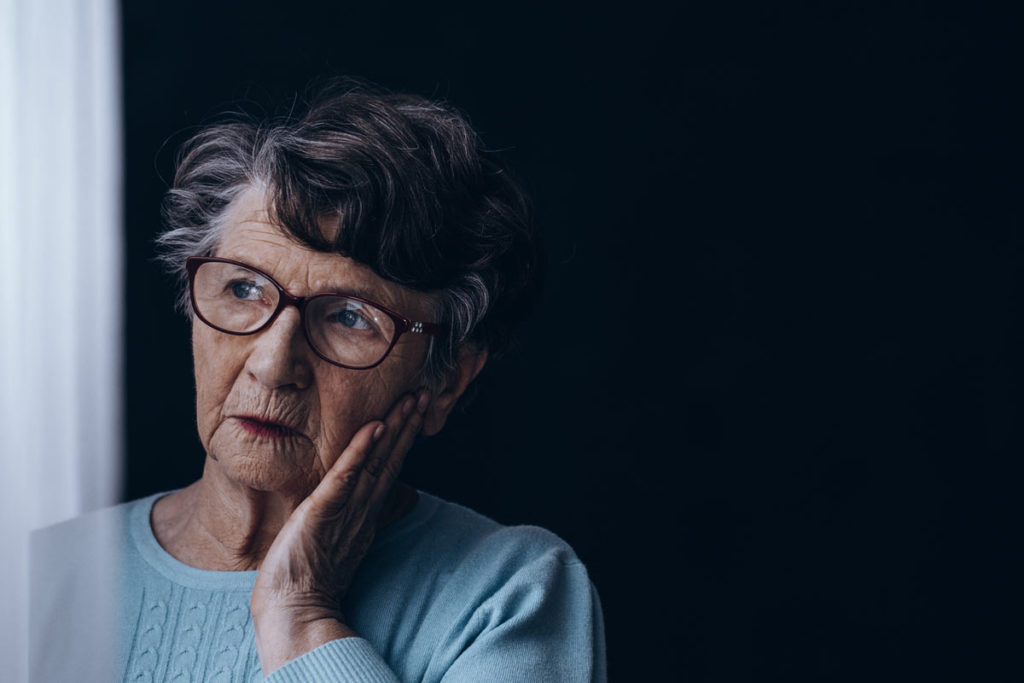Statistics provided by the CDC also tell us that an overwhelming majority of suicide victims are male versus female. In fact, 84 percent of those with no known mental health condition are typically male, with the remaining 16 percent female. Even those with mental health issues are predominately male, accounting for 69 percent of suicides for this particular demographic.
Suicide by firearm is the method used most often (55 percent), but suffocations (27 percent), poisonings (10 percent, and other life-ending options (8 percent) are sometimes pursued as well. But what do we know about suicide as it relates to the elderly, specifically?
Suicide and the Elderly
While older adults only account for 12 percent of the U.S. population, they account for 18 percent of suicide deaths, according to the American Association for Marriage and Family Therapy (AAMFT). Additionally, this risk increases with age; 75- to 85-year-olds having higher rates of suicide than those who are between 65 and 75, and individuals 85 or older have the highest risk yet.
The AAMFT also reports that the rates of elderly suicide are estimated to be under reported by 40 percent or more due to “silent suicides”—overdoses, self-starvation, self-dehydration, and “accidents.” However, the organization says that this portion of the population has a high suicide completion rate. This is mainly because of the methods they choose, which are typically easier to deduce as actual suicides and thus reported more correctly. The methods include using firearms, hangings, and drownings.
Elderly individuals also tend to have higher double-suicide rates, which involves both partners taking their own lives at the same time, according to the AAMFT.
Factors That Raise the Risk of Elderly Suicide
The second most commonly reported cause of suicide is experiencing a life crisis within the previous two weeks

Although many people believe that mental health issues are behind a majority of the suicides that occur today, the CDC indicates that this is not the case as more than half of those who die by self-inflicted harm (54 percent) have no known mental condition.
Additionally, there is no single factor that leads to suicide, according to the CDC, but more of a conglomeration of issues that lead to the decision. Here are a few to consider, in order from most common to least.
Relationship Issues
Relationship issues are the top cause of suicide. One multi-study review published in the Journal of Family Issues reported that out of 19 different pieces of research, 12 showed a higher risk of suicide for men post-breakup and two showed a greater risk for women.
This issue is of particular importance to those over 50 as Pew Research Center has discovered that this age group had a 109 percent increase in divorces between 1990 and 2015.
Psychology Today shares that breaking up is particularly hard on people because romantic relationships involve “a significant investment of time, emotional bonding, shared friendship, and property.” Therefore, when all of this ends, a person’s sense of identity changes while they’re also experiencing loss.
Experiencing A Life Crisis
The second most commonly reported cause of suicide is experiencing a life crisis within the previous two weeks or even facing a future event that is expected to occur in the same time frame. One such life crisis, in the case of the elderly especially, would be the loss of a spouse.
For instance, the CDC reports that, while the average life expectancy in the U.S. is 78.6 years, this age changes based on gender. Specifically, the average lifespan for males is 76.1 years, whereas females typically live to be 81.1—a five-year difference. So, in heterosexual relationships, women can expect to outlive men. In fact, 53.5 percent of Americans over the age of 50 are women, according to the AARP.
Losing a loved one is never easy, regardless of who passes first, and Psychology Today indicates that the loneliness is especially problematic for seniors, often elevating their levels of depression. This puts them at a higher risk of suicide, as well as increasing their participation in risky behaviors also associated with elevated suicide risk, such as drinking and doing drugs.
Substance Abuse
Research published in the journal Clinics in Geriatric Medicine reveals that though the elderly are generally not thought of as substance abusers, evidence suggests that substance use disorder for people over 50 is expected to increase by 2.9 million people by the year 2020. The CDC’s numbers seem to substantiate this and reveal that the third most common risk factor of elderly suicide is problematic substance abuse, an issue reported in approximately one of three suicide cases.
Another study, this one published in Alcohol and Alcoholism, found similar results. After looking at 85 suicides with victims 65 years old and older, researchers learned that more than 35 percent of the men who died by suicide had a history of alcohol dependence or misuse. The same was true for nearly 18 percent of women.
Physical Health Issues
In September 2017, the American Journal of Preventive Medicine published research involving 2,674 individuals who committed suicide, comparing them against 267,400 control subjects in an attempt to discover whether physical health had any influence on the victim’s decision.
After analyzing all of the data, researchers discovered that while almost all of the 17 health conditions considered increased suicide risk, three in particular increased the risk two-fold: traumatic brain injury, sleep disorders, and HIV (human immunodeficiency virus) or AIDS (acquired immune deficiency syndrome). Additionally, the presence of more than one health condition “increased suicide risk substantially.”
Parkinson’s disease is another physical health issue that can increase suicide risk, with one study in the journal Movement Disorders finding that one out of three individuals with this disease have active suicidal or death ideations.
Employment And/Or Financial Factors
Getting older is often associated with retiring from a long work career, but the Bureau of Labor Statistics (BLS) reports that this isn’t exactly the case as 40 percent of individuals 55 years old or older are either working or actively looking for work. Additionally, this number is expected to increase for those 65 and older between now and 2024.
The BLS goes on to say that the reason the baby-boomer generation is working later in life is partially because they’re healthier and able. But some older adults work due to financial reasons such as Social Security benefit changes or because they need to save more cash before retirement is even an option.
The National Council on Aging (NCOA) reaffirms that many of today’s elderly are strapped financially, with more than 25 million Americans 60 years old and older living at or below the federal poverty level. This leaves them struggling to pay their housing costs and medical bills, while also impacting their ability to cover simpler expenses, such as groceries and transportation.
These types of stresses can add up, causing an elderly person to consider suicide in an attempt to release the pressure.
Legal Issues
According to the CDC, in approximately one out of ten cases, the person who dies by suicide has some type of legal issues that likely contributed to his or her death. Other researchers suggest that this number is probably much higher.
For instance, research published in the Archives of General Psychiatry looked at 27,219 suicides over a 25-year period and found that more than one-third of the victims had some type of criminal history. Additionally, though risk of suicide with regard to criminal history was higher for women than it was for men, both genders had elevated risks the more extensive their history was and the more violent their crimes.
Compounding this issue further are research studies that have found that older individuals with criminal records report being discriminated against by healthcare workers. This can be particularly impactful as a person ages, because older adults generally have higher rates of chronic disease (80 percent), falls (one every 11 seconds), and mental health disorders (one in four), according to NCOA, all of which require care.
Housing-Related Stress
Some individuals commit suicide due to housing-related stress, according to the CDC.
In the book “The Social and Built Environment in an Older Society,” author Raymond J. Struyk says that the housing issues the elderly typically face include “deficiencies in the dwelling, the high price of housing relative to income, and overcrowded conditions.”
Yet, sometimes housing problems exist because of neighborhood issues or based on whether shopping centers and quality medical services are within close proximity and easy to access.
Detecting Early Suicide Warning Signs in Older Adults
It’s important that you get help, even if it means sharing what they’ve said to you with others.

How do you know whether the elderly person in your life may be contemplating suicide? Mental Health America says there are many warning signs that could indicate that suicide is being considered:
- The person expresses depression or hopelessness
- There has been a loss of independence
- Having been diagnosed with a serious medical condition that could either dramatically change quality of life or end it prematurely
- The senior is isolated socially
- A loved one has recently died or there are family issues
- Lack of desire or inability to deal with change
- Risky behaviors are exhibited
- Substance use or abuse has increased
- Suicide has been attempted previously, or he or she makes statements indicating that life would be better if they weren’t around
- Valuable possessions are no longer important and may be given away
Suicide Prevention Options for Seniors

If these signs are present or you’re otherwise concerned someone may be deciding to take his or her own life, there are many things you can do to help reduce this risk.
Talk With Them
The Substance Abuse and Mental Health Services Administration (SAMHSA) says that taking the time to have caring, nonjudgmental conversations with an elderly person who may be considering suicide can sometimes help. When speaking with them, the SAMHSA recommends encouraging them to take advantage of wellness classes offered at area senior centers.
If necessary, you can even find the senior centers first to identify the options that exist before talking to your loved one about the benefits each would provide. For instance, some senior centers offer classes related to hobbies and special interests, potentially reigniting a spark for activities that they enjoy. Even fitness classes can potentially help as Harvard Health shares that physical activity is a natural depression treatment.
When talking with your senior, the Mayo Clinic says that you never want to promise that you’ll keep their suicidal thoughts to yourself. If you believe their life is in danger, it’s important that you get help, even if it means sharing what they’ve said to you with others.
Connect Them With Elderly Support Groups
Another option is to help them find support groups so they can connect with other seniors who are struggling with the same type of life issues. For instance, if they are depressed because they lost a spouse or someone close to them, you may encourage them to find a grief support group. If you’re not familiar with one in your area, Grief.com offers an online search option.
Or maybe it is the elderly person’s physical health that has him or her contemplating suicide. There are support groups for all types of conditions, such as cancer, heart disease, Parkinson’s, and Alzheimer’s. Some are available at local medical care facilities, whereas others may be interspersed throughout the community and held at schools, in libraries, or at organizations that deal specifically with that disease.
Limit Access To Substances
Because problematic substance use is present in 28 percent of suicides, limiting your loved one’s access to drugs and alcohol can potentially keep them from taking their own life while under the influence. Some will hide their drug of choice, according to a thread on DrugAbuse.com, so you may need to look in unconventional places for their stash, such as behind books, under seat cushions, under sinks, in closets, and even in toilet tanks.
That being said, if the elderly person is addicted to a substance, additional actions may need to be taken to ensure that they withdraw from it safely once it is removed from the home. For instance, acute alcohol withdrawal can actually be deadly. So, in this case, you’d want to arrange for a safe withdrawal experience either at a rehab center or local medical facility.
Remove Lethal Means
Perhaps most importantly, if you suspect that the elderly person in your life is contemplating suicide, remove any lethal means that would make it easier for them to go through with the act.
If they have firearms, for instance, get them out of their home and give them to someone who can keep them safe until the elderly person’s situation improves. And if they have medications that can easily be overdosed, you may want to remove those as well (as long as it doesn’t impact their quality of care).
Admittedly, there isn’t much you can do in regard to some of the other lethal means that individuals can use to take their lives, like suffocations or poisonings with household cleaners. But the harder you make it for them to have access to the methods that can end their lives prematurely, the greater your ability to thwart their plans long enough to get them help so they no longer want to take this action.
Developing a Response Plan if Suicide Is Suspected
Knowing what to look for and how to best thwart this type of act, as well as how to respond should they actually attempt it, can help you help your loved ones

If you feel that suicide is imminent, your response could be the difference between them succeeding or having the opportunity to potentially fight the issues that plague them.
According to the Mayo Clinic, the first step is to sensitively, yet directly, ask the elderly person questions to help you determine how serious the person is about suicide. This involves asking:
- How they are coping with things
- Whether they’re thinking about dying or giving up
- Whether they’re thinking about suicide specifically
- Whether they’ve tried suicide in the past (if you don’t already know)
- Whether they have access to anything that can be used to end their own life
While you may be concerned that your line of questioning could incite the person to want to act on his or her suicidal thoughts, the Mayo Clinic shares that it won’t. Instead, it may actually provide an outlet for them to open up and talk about things, potentially reducing the desire to do it versus making it worse.
If their answers or actions make you suspect that suicide is a possibility, the Mayo Clinic suggests that you “get help from a trained professional as quickly as possible.”
In the meantime, you can also encourage him or her to call the National Suicide Prevention Lifeline at (800) 273-8255 to talk to someone trained to deal with this type of situation.
If Suicide Is Attempted
In the event that the elderly person attempts suicide and you find him or her, the Mayo Clinic says to call 911 or your local emergency number immediately while remaining at their side. Alternatively, if you feel comfortable and can do it safely, you can transport him or her to the emergency room.
If possible, the Mayo Clinic recommends that you try to determine if the elderly person used alcohol or drugs, which may be readily apparent if liquor bottles or prescription bottles are in the immediate vicinity. If so, this could help the medical care facility create the best treatment plan possible.
Elderly suicide is a major issue and one that involves many different factors. However, knowing what to look for and how to best thwart this type of act, as well as how to respond should they actually attempt it, can help you help your loved ones. It can give them the opportunity to consider the fact that suicide isn’t the best—or only—response that can give them peace, whatever their issues are.
Approximately 30% of people with psoriasis develop a form of inflammatory arthritis called psoriatic arthritis.
